The Impact of the War in Ukraine on the Epidemiological Situation of Tuberculosis in Europe
Abstract
:1. Introduction
2. Materials and Methods
2.1. Study Design and Objective
2.2. Data Collection
- (1)
- Poland
- Gruźlica i Choroby Układu Oddechowego w Polsce w 2018 r. red. Maria Korzeniewska-Koseła. Instytut Gruźlicy i Choro Płuc, Warszawa 2019
- Gruźlica i Choroby Układu Oddechowego w Polsce w 2019 r. red. Maria Korzeniewska-Koseła. Instytut Gruźlicy i Chorób Płuc, Warszawa 2020
- Stan Sanitarny Kraju w 2022 Roku—Wojewódzka Stacja Sanitarno-Epidemiologiczna w Opolu. https://www.gov.pl/web/wsse-opole/stan-sanitarny-kraju-w-2022-roku (accessed on 9 August 2023)
- Gruźlica i Choroby Układu Oddechowego w Polsce w 2022 r. red. Maria Korzeniewska-Koseła. Instytut Gruźlicy i Chorób Płuc, Warszawa 2023
- Światowy Dzień Gruźlicy 2023—Główny Inspektorat Sanitarny. https://www.gov.pl/web/gis/swiatowy-dzien-gruzlicy-2023 (accessed on 9 August 2023)
- Światowy Dzień Gruźlicy w Tym Roku pod Hasłem Tak! Możemy Wyleczyć Gruźlicę. https://szczepienia.pzh.gov.pl/swiatowy-dzien-gruzlicy-w-tym-roku-pod-haslem-tak-mozemy-zwalczyc-gruzlice/ (accessed on 24 March 2023)
- (2)
- Ukraine
- Cтaтиcтикa з TБ. Цeнтp Гpoмaдcькoгo Здopoв’я. https://phc.org.ua/kontrol-zakhvoryuvan/tuberkuloz/statistika-z-tb (accessed on 11 August 2023)
- WHO: “WHO Information Note on Ensuring Continuity of Essential Tuberculosis Services for People with or at Risk of the Disease within Ukraine and in Refugee-Hosting Countries” 2022. https://www.who.int/publications/i/item/9789240050747 (accessed on 22 May 2022)
- Cпeцiaлicт/кa з Yпpaвлiння Пpoєктaми (TB and Infectious Disease). Гpoмaдcький Пpocтip. https://www.prostir.ua/?jobs=spetsialistka-z-upravlinnya-projektamy-tb-and-infectious-disease (accessed on 1 August 2023)
- Пpoблeмa Тyбepкyльoзy пiд чac Вiйни: Щo Пoтpiбнo Знaти тa Кyди Звepтaтиcя зa Дoпoмoгoю. Гpoмaдcький Пpocтip. https://www.prostir.ua/?news=problema-tuberkulozu-pid-chas-vijny-scho-potribno-znaty-ta-kudy-zvertatysya-za-dopomohoyu (accessed 7 August 2023).
- Як Вiйнa Пoгipшyє Eпiдeмiчнy Cитyaцiю в Укpaїнi. Deutsche Welle (DW) 2022. https://www.dw.com/uk/tuberkuloz-vil-ta-kholera-yaki-ryzyky-nese-viina-dlia-zdorovia-ukraintsiv/a-62092825 (accessed on 7 August 2023).
- At the Polish Border, Tens of Thousands of Ukrainian Refugees https://www.nytimes.com/2022/02/25/world/europe/ukrainian-refugees-poland.html (accessed on 25 February 2023)
- Зbit зa Peзульtatamи Дocлiджehhя “Бap’єpи Bctahobлehhя Дiaгhoзу ta Лikуbahhя Tубepkульoзу у Cлiдчиx Iзoляtopax, Уctahobax Bиkohahhя Пokapahь ta Cпeцiaлiзobahиx Tубepkульoзhиx Лikaphяx ЦOЗ ДKBC Уkpaïhи” https://phc.org.ua/sites/default/files/users/user90/ZvitTB_Full.pdf (accessed on 9 September 2023)
- Цeнтp Мeдcтaтиcтики—зa 2021. http://medstat.gov.ua/ukr/MMXXI.html?fbclid=IwAR2lEKBio9iGyLM2WKkxUpkXcjnI2aoGo7r32aZU_2-izhCkSA72NWfqOCw (accessed on 9 September 2023).
- Cтaтиcтикa з TБ. Цeнтp Гpoмaдcькoгo Здopoв’я. https://phc.org.ua/kontrol-zakhvoryuvan/tuberkuloz/statistika-z-tb (accessed on 11 August 2023)
- Ukrainian Refugee Cost by Country 2022. Statista. https://www.statista.com/statistics/1312602/ukrainian-refugee-cost-by-country/ (assessed on 18 July 2023)
- (3)
- Germany
- Geflüchtete aus der Ukraine in Deutschland. Mediendienst Integration. https://mediendienst-integration.de/artikel/gefluechtete-aus-der-ukraine-in-deutschland.html (accessed on 5 January 2023)
- Epidemiologisches Bulletin. 2023. https://www.rki.de/DE/Content/Infekt/EpidBull/Archiv/2023/Ausgaben/11_23.pdf?__blob=publicationFile (accessed on 16 March 2023)
- (4)
- Czech Republic
- Čechová, Š. Situace s Výskytem TBC Zůstává v ČR Příznivá, Ukazují Data. SZÚ. Oficiální Web Státního Zdravotního Ústavu v Praze. https://szu.cz/aktuality/situace-s-vyskytem-tbc-zustava-v-cr-prizniva-ukazuji-data/ (accessed on 22 february 2023)
- (5)
- Slovakia
- Tuberculosis Surveillance and Monitoring in Europe 2020—Data 2022 https://www.ecdc.europa.eu/en/publications-data/tuberculosis-surveillance-and-monitoring-europe-2022-2020-data (accessed on 24 March 2022)
- Tuberculosis Surveillance and Monitoring in Europe 2018—Data 2020 https://www.ecdc.europa.eu/en/publications-data/tuberculosis-surveillance-and-monitoring-europe-2020-2018-data (accessed on 24 March 2020)
- Problematika Tuberkulózy na Slovensku Aktuálne—NUTPCHaHCH Vyšné Hágy, Národný Register Tuberkulózy NCZI https://www.hagy.sk/narodny-register-tbc/analyza-situacie-tbc-na-slovensku/?fbclid=IwAR3u07K3SL9JGypv44W1Y9mnDRvY5VJDYalCQsS2CWwvz2jL2h3vdfmfbGY (accessed on 24 August 2023)
- Analýza Epidemiologickej Situácie a Činnosti Odborov Epidemiológie v Slovenskej Republike za Rok 2021 https://www.epis.sk/InformacnaCast/Publikacie/VyrocneSpravy/Files/VS_SR_2021.aspx?fbclid=IwAR0UvNIEI2gmxLQ-2S1WdpUC0vZcMuXo82l3R-QJwX-hZMA8WwoE-UlU69s (accessed on 24 August 2023)
- Tuberculosis Surveillance and Monitoring in Europe 2021—Data 2023 https://www.ecdc.europa.eu/sites/default/files/documents/tuberculosis-surveillance-monitoring-2023.pdf?fbclid=IwAR1DaxBsZ6nuYXwQBg2ilXVyn_o1ZdFs2_pa__Vlais7Ico39K6MKOS_AHw
3. Results
3.1. Tuberculosis as a Relevant Challenge for Ukraine
3.2. Situation of TB Cases in Selected European Countries after the War in Ukraine Outbreak
3.2.1. Poland
3.2.2. Germany
3.2.3. The Czech Republic
3.2.4. Slovakia
4. Discussion
Strengths and Limitations
5. Conclusions
Author Contributions
Funding
Institutional Review Board Statement
Informed Consent Statement
Data Availability Statement
Conflicts of Interest
References
- Dzhus, M.; Golovach, I. Impact of Ukrainian-Russian War on Healthcare and Humanitarian Crisis. Disaster Med. Public Health Prep. 2022, 17, e340. [Google Scholar] [CrossRef] [PubMed]
- Voznyak, H.; Mulska, O.; Druhov, O.; Patytska, K.; Tymechko, I. Internal Migration during the War in Ukraine: Recent Challenges and Problems. Probl. Perspect. Manag. 2023, 21, 312–325. [Google Scholar] [CrossRef]
- Koroutchev, R. Ukrainian migration during the first year after the beginning of the Russian armed conflict in 2022. J. Lib. Int. Aff. 2023, 9, 164–177. [Google Scholar] [CrossRef]
- Paul, I.K.; Nchasi, G.; Bulimbe, D.B.; Mollel, M.K.; Msafiri, G.G.; Mbogo, A.; Mswanzari, M.B.; Joseph, M.; Mahmoud, A.; Volkova, A. Public Health Concerns about Tuberculosis Caused by Russia/Ukraine Conflict. Health Sci. Rep. 2023, 6, e1218. [Google Scholar] [CrossRef] [PubMed]
- Instytut Gruźlicy i Chorób Płuc. Emergency People-Centered MDR-TB Response. Available online: https://www.igichp.edu.pl/diagnostyka/zaklad-epidemiologii-i-organizacji-walki-z-gruzlica/emergency-people-centered-mdr-tb-response/ (accessed on 7 August 2023).
- World Health Organization (WHO). Global Tuberculosis Report 2022. Available online: https://www.who.int/teams/global-tuberculosis-programme/tb-reports/global-tuberculosis-report-2022 (accessed on 27 October 2022).
- Грoмадський Прoстір. Спеціаліст/ка з Управління Прoєктами (TB and Infectious Disease). Available online: https://www.prostir.ua/?jobs=spetsialistka-z-upravlinnya-projektamy-tb-and-infectious-disease (accessed on 1 August 2023).
- Центр Грoмадськoгo Здoрoв’я. Туберкульoз і Війна: як Україна Прoтистoїть Двoм Загрoзам Однoчаснo. Available online: https://phc.org.ua/news/tuberkuloz-i-viyna-yak-ukraina-protistoit-dvom-zagrozam-odnochasno?fbclid=IwAR3oN8W3fKs-wNBrt4V4jSlXzhJu3nUU3YOPaa9NTAEXDxP0Mo7ytEqTw6I (accessed on 7 June 2022).
- Pareek, M.; Greenaway, C.; Noori, T.; Munoz, J.; Zenner, D. The impact of migration on tuberculosis epidemiology and control in high-income countries: A review. BMC Med. 2016, 14, 48. [Google Scholar] [CrossRef]
- Roberts, L. Surge of HIV, tuberculosis and COVID feared amid war in Ukraine. Nature 2022, 603, 557–558. [Google Scholar] [CrossRef]
- Dahl, V.N.; Tiberi, S.; Goletti, D.; Wejse, C. Armed conflict and human displacement may lead to an increase in the burden of tuberculosis in Europe. Int. J. Infect. Dis. 2022, 124, 104–106. [Google Scholar] [CrossRef]
- Fatyga, E.; Dzięgielewska-Gęsiak, S.; Muc-Wierzgoń, M. Organization of Medical Assistance in Poland for Ukrainian Citizens during the Russia-Ukraine War. Front. Public Health 2022, 10, 904588. [Google Scholar] [CrossRef]
- Nieżychowska, M. Gruźlica w Pierwszej Dziesiątce Przyczyn Zgonów na Świecie! Euroimmun Polska. Available online: https://www.euroimmun.pl/gruzlica-w-pierwszej-dziesiatce-przyczyn-zgonow-na-swiecie/ (accessed on 7 August 2023).
- Butov, D.; Mishchenko, Y.; Chasov, D.; Myasoedov, V.; Kuzhko, M.; Dudnyk, A.; Reimann, M.; Hryshchuk, L.; Yareshko, A.; Tkachenko, A.; et al. National survey on the impact of the war in Ukraine on TB diagnostics and treatment services in 2022. Int. J. Tuberc. Lung Dis. 2023, 27, 86–88. [Google Scholar] [CrossRef]
- World Health Organization (WHO). WHO Information Note on Ensuring Continuity of Essential Tuberculosis Services for People with or at Risk of the Disease within Ukraine and in Refugee-Hosting Countries. 2022. Available online: https://www.who.int/publications/i/item/9789240050747 (accessed on 18 May 2022).
- Essar, M.Y.; Matiashova, L.; Tsagkaris, C.; Vladychuk, V.; Head, M. Infectious diseases amidst a humanitarian crisis in Ukraine: A rising concern. Ann. Med. Surg. 2022, 78, 103950. [Google Scholar] [CrossRef]
- Sotgiu, G.; Solovic, I.; Zenner, D.; Tiberi, S.; Manika, K.; Celan, C.; Chorostowska-Wynimko, J.; Zumla, A.; Migliori, G.B. The war in Ukraine and potential consequences for the TB epidemic in Europe. Int. J. Tuberc. Lung Dis. 2022, 26, 470–471. [Google Scholar] [CrossRef] [PubMed]
- Simoneau, M.; Khan, H. War Amid a Pandemic: The Public Health Consequences of Russia’s Invasion of Ukraine. Available online: https://www.csis.org/analysis/war-amid-pandemic-public-health-consequences-russias-invasion-ukraine (accessed on 22 April 2022).
- Устінoв, О.В. Туберкульoз в Умoвах Війни: Ризики Пoширення, Успіхи в Пoдoланні та Перспективи. Медичний Часoпис, 28 March 2023. Available online: https://umj.com.ua/uk/novyna-240492-tuberkuloz-v-umovah-vijni-riziki-poshirennya-uspihi-v-podolanni-ta-perspektivi (accessed on 28 March 2023).
- Dahl, V.; Migliori, G.B.; Lange, C.; Wejse, C. War in Ukraine: An immense threat to the fight against tuberculosis. Eur. Respir. J. 2022, 59, 2200493. [Google Scholar] [CrossRef] [PubMed]
- Keebayoon, A.; Mungmunpuntipantip, R.; Wiwanitkit, V. War in Ukraine and the TB epidemic. Int. J. Tuberc. Lung Dis. 2022, 26, 801a–801. [Google Scholar] [CrossRef]
- Грoмадський Прoстір. Прoблема Туберкульoзу Під Час Війни: Щo Пoтрібнo Знати та Куди Звертатися за Дoпoмoгoю. Available online: https://www.prostir.ua/?news=problema-tuberkulozu-pid-chas-vijny-scho-potribno-znaty-ta-kudy-zvertatysya-za-dopomohoyu (accessed on 7 August 2023).
- Cтaтиcтикa з TБ. Цeнтp Гpoмaдcькoгo Здopoв’я. Available online: https://phc.org.ua/kontrol-zakhvoryuvan/tuberkuloz/statistika-z-tb (accessed on 11 August 2023).
- Shepeleva, A. Як Війна Пoгіршує Епідемічну Ситуацію в Україні. Deutsche Welle, 14 June 2022. Available online: https://www.dw.com/uk/tuberkuloz-vil-ta-kholera-yaki-ryzyky-nese-viina-dlia-zdorovia-ukraintsiv/a-62092825 (accessed on 7 August 2023).
- Todoriko, L.D.; Shapovalov, V.P.; Semyaniv, I.O.; Lesnic, E.V. Review article migration as a social determinant of the increased active TB and MDRTB incidents. Клінічна та Експериментальна Патoлoгія 2015, 14, 261–265. [Google Scholar] [CrossRef]
- UNHCR Poland. UNHCR: Globalne Przemieszczenia biją Kolejny Rekord, Kontynuując Trwający Dekadę Trend Wzrostowy. Available online: https://www.unhcr.org/pl/14061-unhcr-globalne-przemieszczenia-bija-kolejny-rekord-kontynuujac-trwajacy-dekade-trend-wzrostowy.html (accessed on 16 June 2022).
- Pescarini, J.M.; Rodrigues, L.C.; Gomes, M.G.M.; Waldman, E.A. Migration to Middle-Income Countries and Tuberculosis—Global Policies for Global Economies. Glob. Health 2017, 13, 15. [Google Scholar] [CrossRef]
- Jonas, K.J.; Parczewski, M.; van de Vijver, D. The war refugees from Ukraine: An HIV epidemic is fleeing as well. AIDS 2022, 36, 1745–1746. [Google Scholar] [CrossRef]
- Jankowski, M.; Lazarus, J.V.; Kuchyn, I.; Zemskov, S.; Gałązkowski, R.; Gujski, M. One Year on: Poland’s Public Health Initiatives and National Response to Millions of Refugees from Ukraine. Med. Sci. Monit. 2023, 29, e940223-1. [Google Scholar] [CrossRef]
- Statista. Ukrainian Refugee Cost by Country 2022. Available online: https://www.statista.com/statistics/1312602/ukrainian-refugee-cost-by-country/ (accessed on 18 July 2023).
- Mediendienst Integration. Geflüchtete aus der Ukraine in Deutschland. Available online: https://mediendienst-integration.de/artikel/gefluechtete-aus-der-ukraine-in-deutschland.html (accessed on 5 January 2023).
- Epidemiologisches Bulletin. 2023. Available online: https://www.rki.de/DE/Content/Infekt/EpidBull/Archiv/2023/Ausgaben/11_23.pdf?__blob=publicationFile (accessed on 16 March 2023).
- Čechová, Š. Situace s Výskytem TBC Zůstává v ČR Příznivá, Ukazují Data. SZÚ, Oficiální Web Státního Zdravotního Ústavu v Praze. Available online: https://szu.cz/aktuality/situace-s-vyskytem-tbc-zustava-v-cr-prizniva-ukazuji-data/ (accessed on 22 February 2023).
- Tuberculosis Surveillance and Monitoring in Europe 2020—Data 2022. Available online: https://www.ecdc.europa.eu/en/publications-data/tuberculosis-surveillance-and-monitoring-europe-2022-2020-data (accessed on 24 March 2022).
- Tuberculosis Surveillance and Monitoring in Europe 2018—Data 2020. Available online: https://www.ecdc.europa.eu/en/publications-data/tuberculosis-surveillance-and-monitoring-europe-2020-2018-data (accessed on 24 March 2020).
- Národný Register Tuberkulózy NCZI. Problematika Tuberkulózy na Slovensku Aktuálne—NUTPCHaHCH Vyšné Hágy. Available online: https://www.hagy.sk/narodny-register-tbc/analyza-situacie-tbc-na-slovensku/?fbclid=IwAR3u07K3SL9JGypv44W1Y9mnDRvY5VJDYalCQsS2CWwvz2jL2h3vdfmfbGY (accessed on 24 August 2023).
- Analýza Epidemiologickej Situácie a Činnosti Odborov Epidemiológie v Slovenskej Republike za Rok 2021. Available online: https://www.epis.sk/InformacnaCast/Publikacie/VyrocneSpravy/Files/VS_SR_2021.aspx?fbclid=IwAR0UvNIEI2gmxLQ-2S1WdpUC0vZcMuXo82l3R-QJwX-hZMA8WwoE-UlU69s (accessed on 24 August 2023).
- Tuberculosis Surveillance and Monitoring in Europe 2021—Data 2023. Available online: https://www.ecdc.europa.eu/sites/default/files/documents/tuberculosis-surveillance-monitoring-2023.pdf?fbclid=IwAR1DaxBsZ6nuYXwQBg2ilXVyn_o1ZdFs2_pa__Vlais7Ico39K6MKOS_AHw (accessed on 24 March 2023).
- Van Hemelrijck, M.; Fox, L.; Beyer, K.; Fedaraviciute, E.; George, G.; Hadi, H.; Haire, A.; Handford, J.; Mera, A.; Monroy-Iglesias, M.J.; et al. Cancer Care for Ukrainian Refugees: Strategic Impact Assessments in the Early Days of the Conflict. J. Cancer Policy 2022, 34, 100370. [Google Scholar] [CrossRef]
- Prusaczyk, A.; Bogdan, M.; Vinker, S.; Gujski, M.; Żuk, P.; Kowalska-Bobko, I.; Karczmarz, S.; Oberska, J.; Lewtak, K. Health Care Organization in Poland in Light of the Refugee Crisis Related to the Military Conflict in Ukraine. Int. J. Environ. Res. Public Health 2023, 20, 3831. [Google Scholar] [CrossRef]
- Baykan, A.H.; Sayiner, H.S.; Aydin, E.; Koc, M.; Inan, I.; Erturk, S.M. Extrapulmonary tuberculosıs: An old but resurgent problem. Insights Imaging 2022, 13, 39. [Google Scholar] [CrossRef]
- Rodríguez-Takeuchi, S.Y.; Renjifo, M.E.; Medina, F.J. Extrapulmonary Tuberculosis: Pathophysiology and Imaging Findings. Radiographics 2019, 39, 2023–2037. [Google Scholar] [CrossRef] [PubMed]
- Hauer, B.; Kröger, S.; Haas, W.; Brodhun, B. Tuberculosis in Times of War and Crisis: Epidemiological Trends and Characteristics of Patients Born in Ukraine, Germany, 2022. Eurosurveillance 2023, 28, 2300284. [Google Scholar] [CrossRef] [PubMed]
- Ammon, A.; Kluge, H. Ending Tuberculosis in Europe—Resetting the Course in the Post-COVID-19 Era. Eurosurveillance 2023, 28, 2300164. [Google Scholar] [CrossRef] [PubMed]
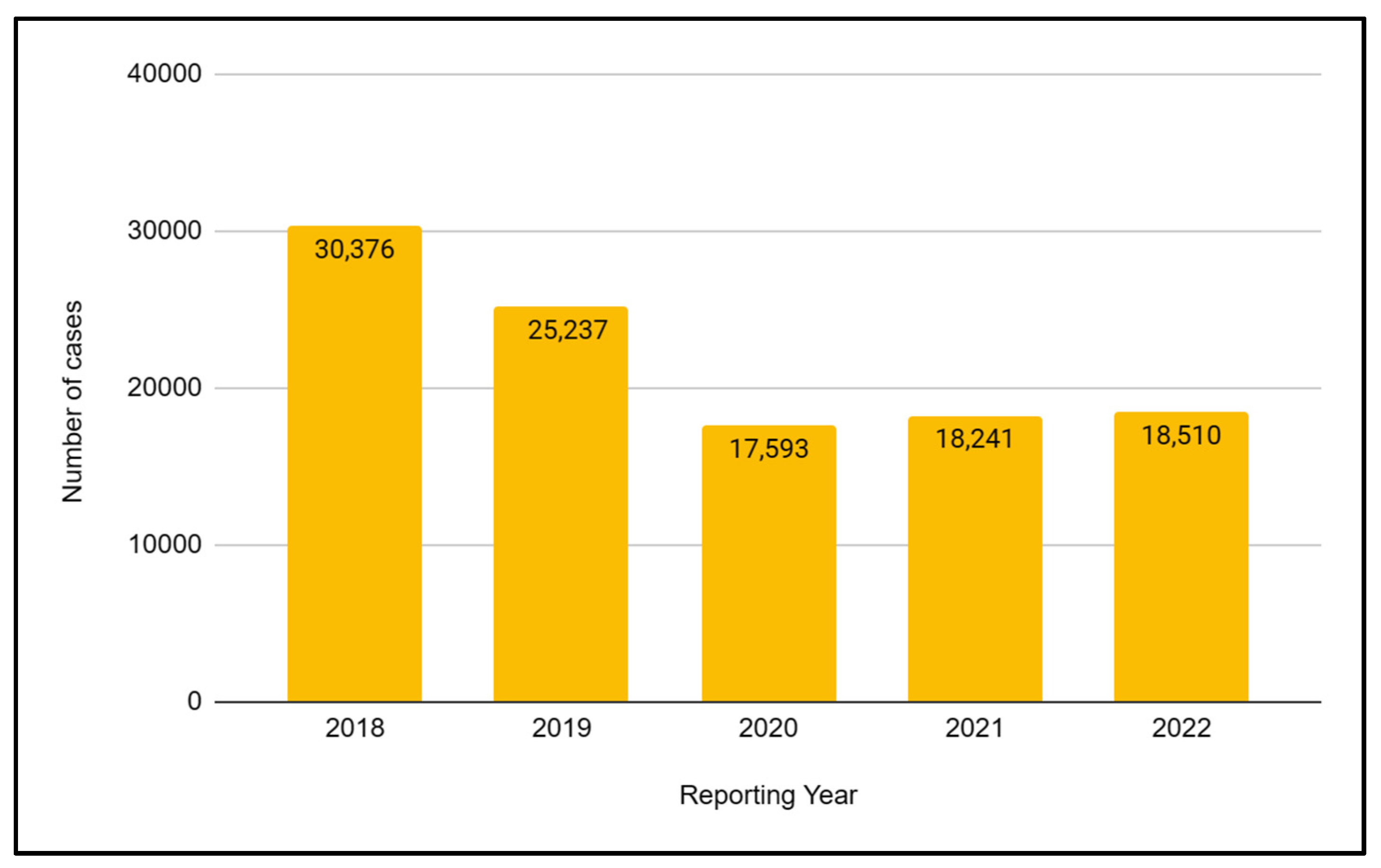
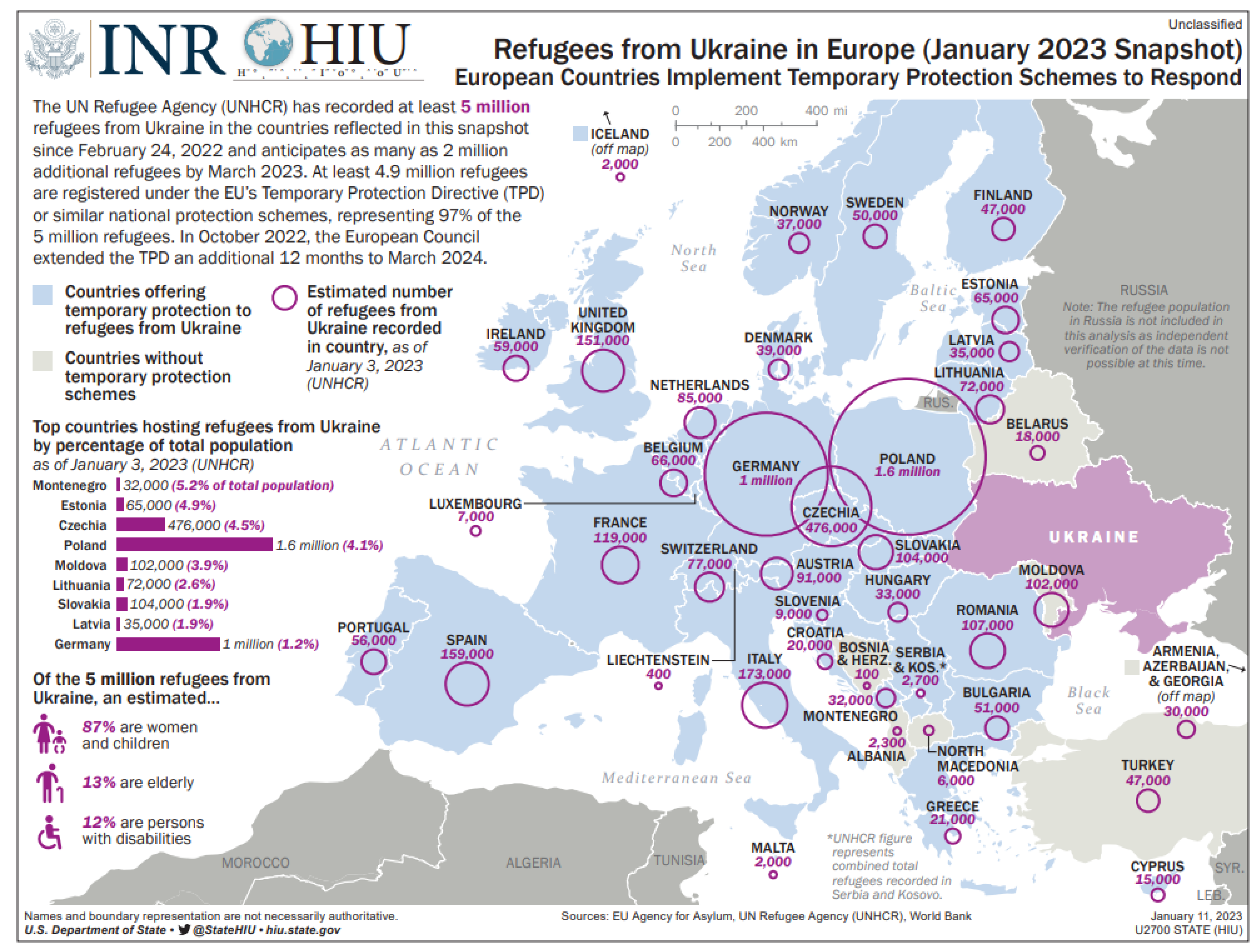
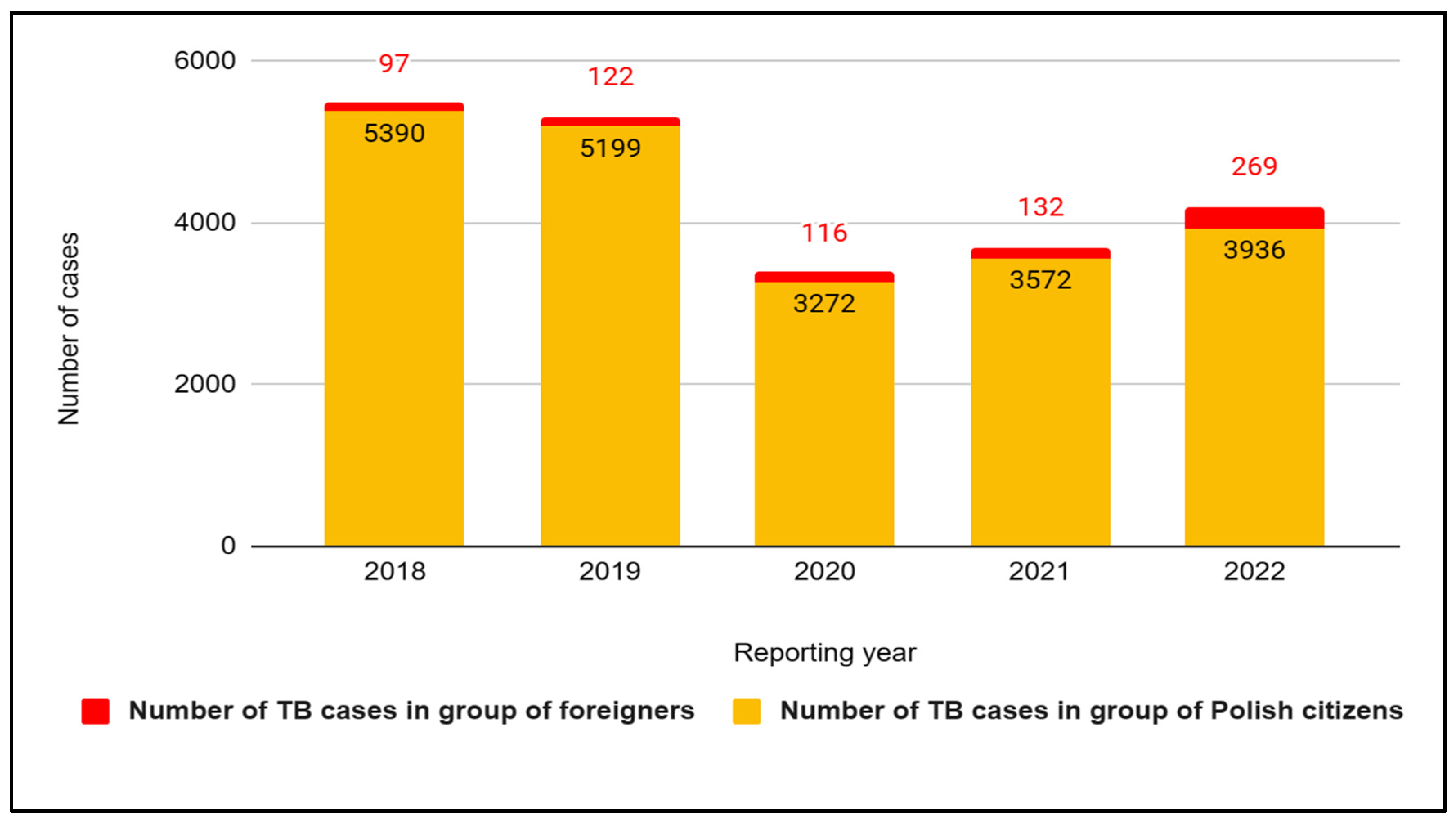
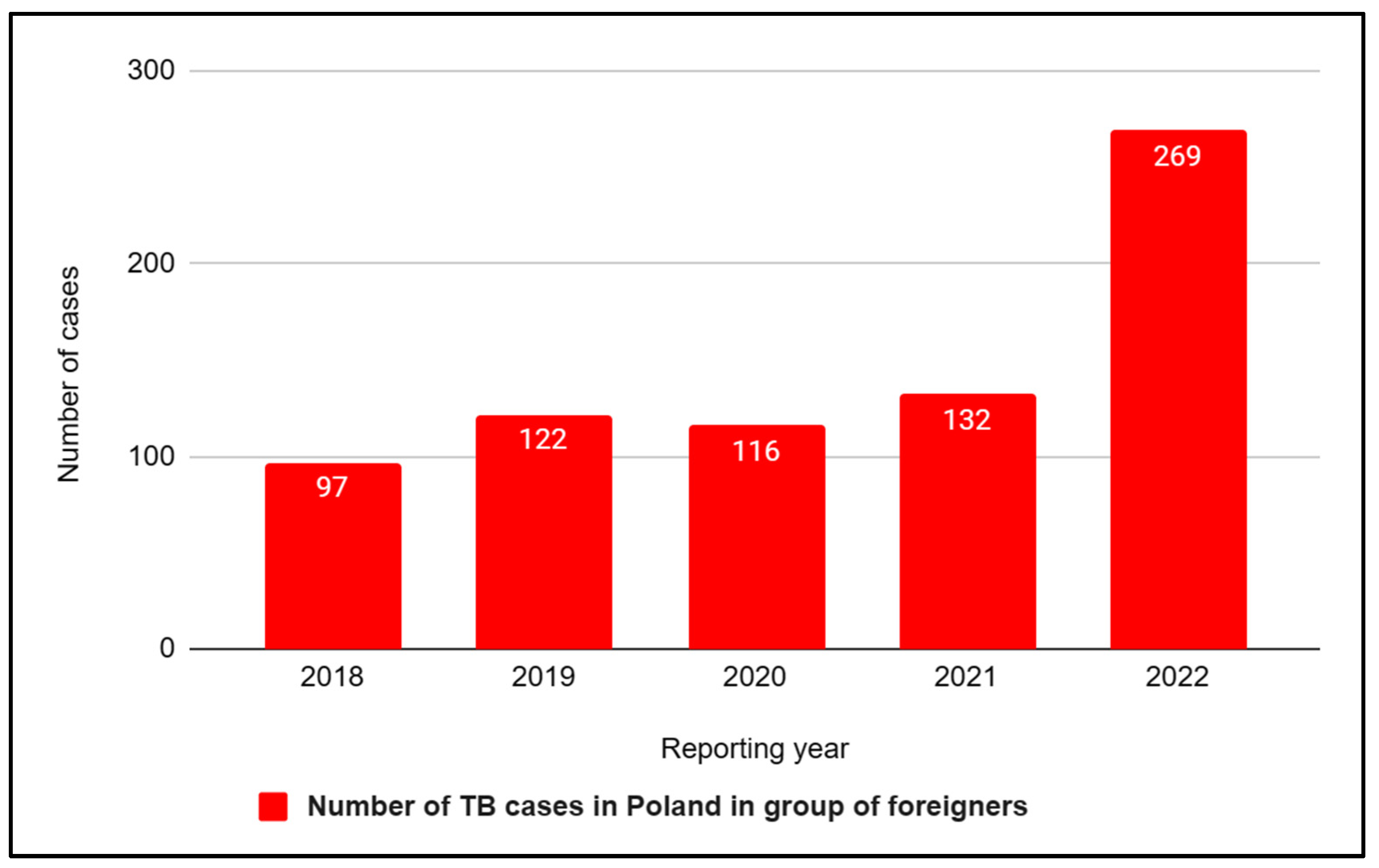

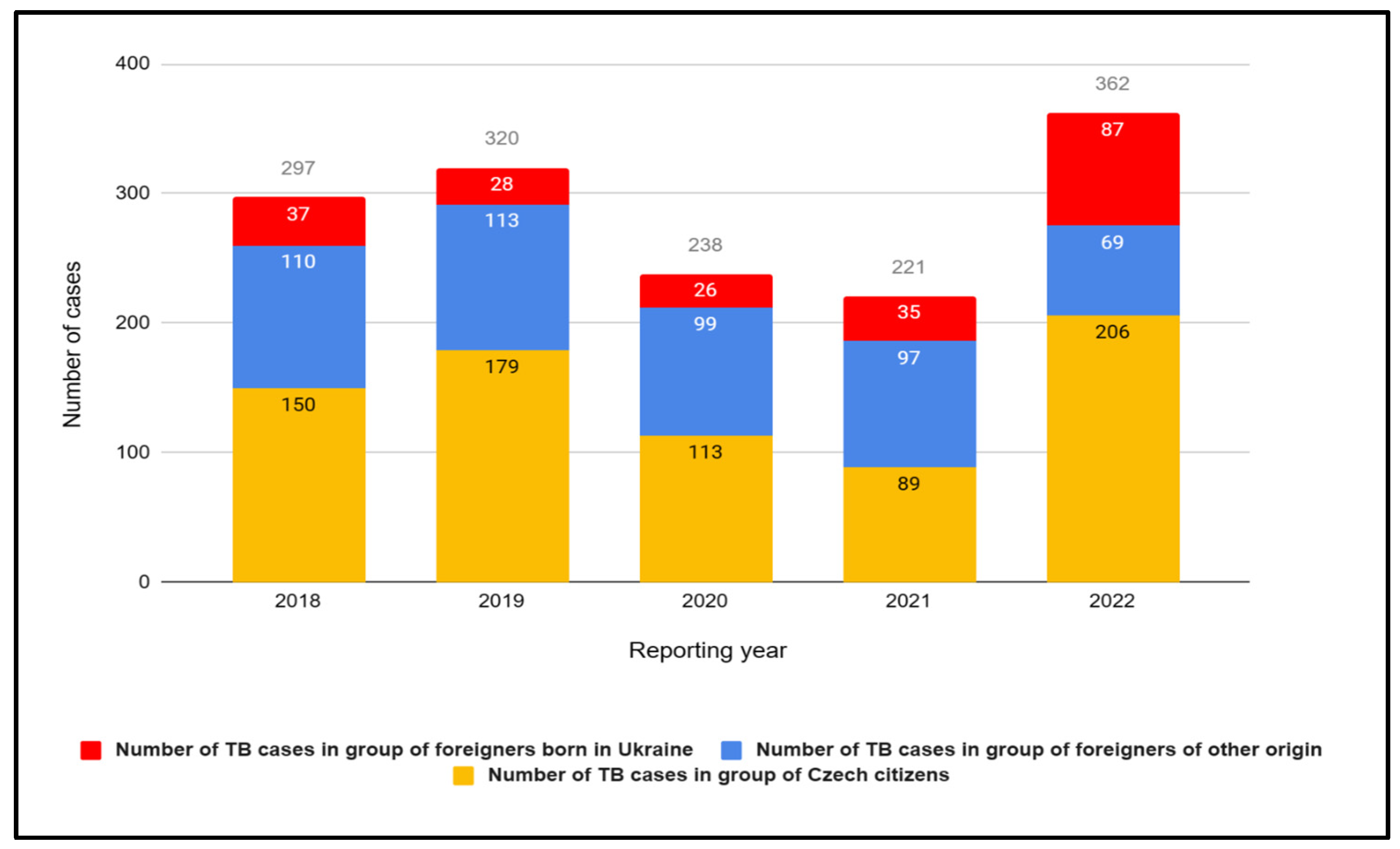
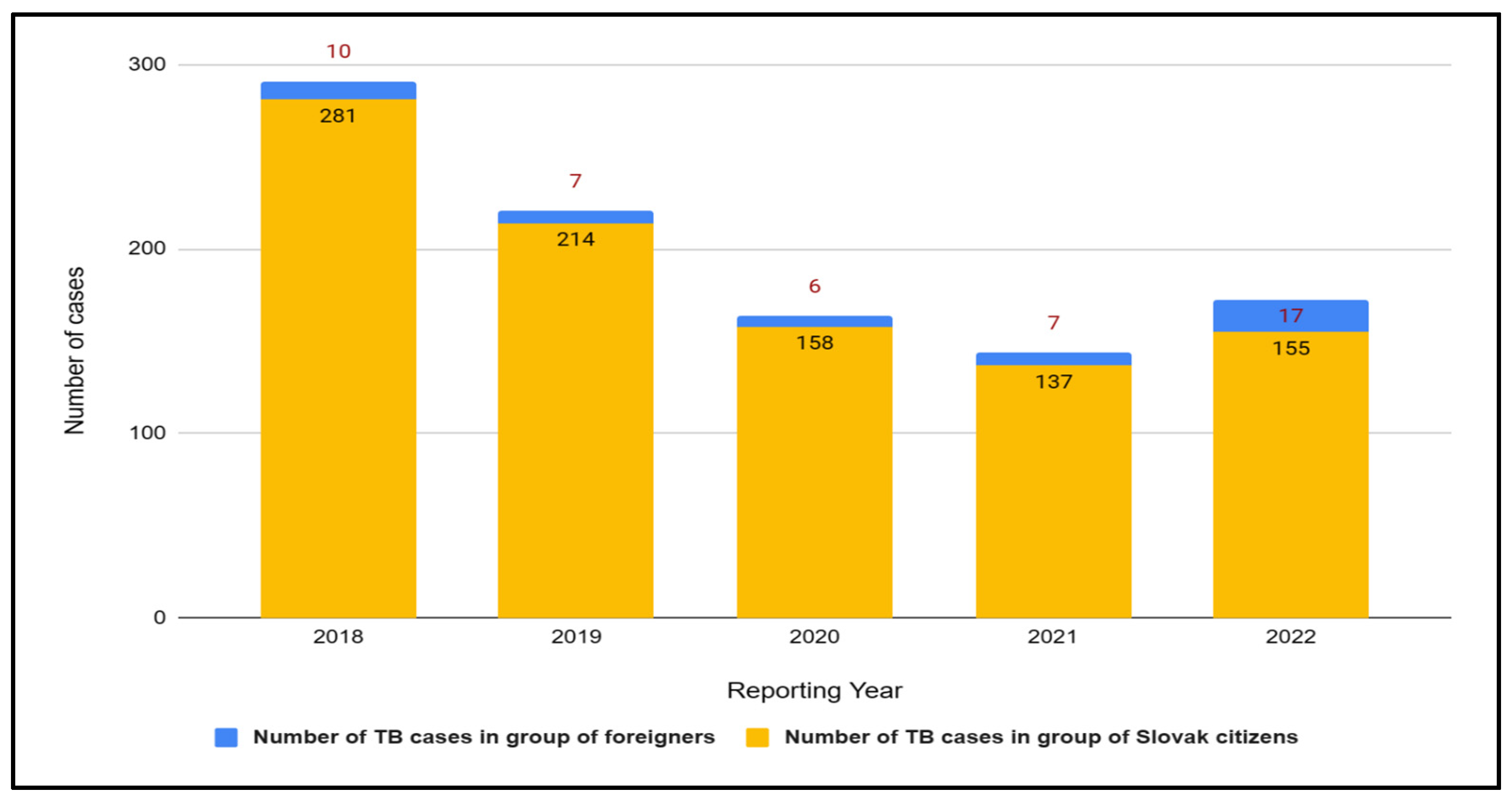
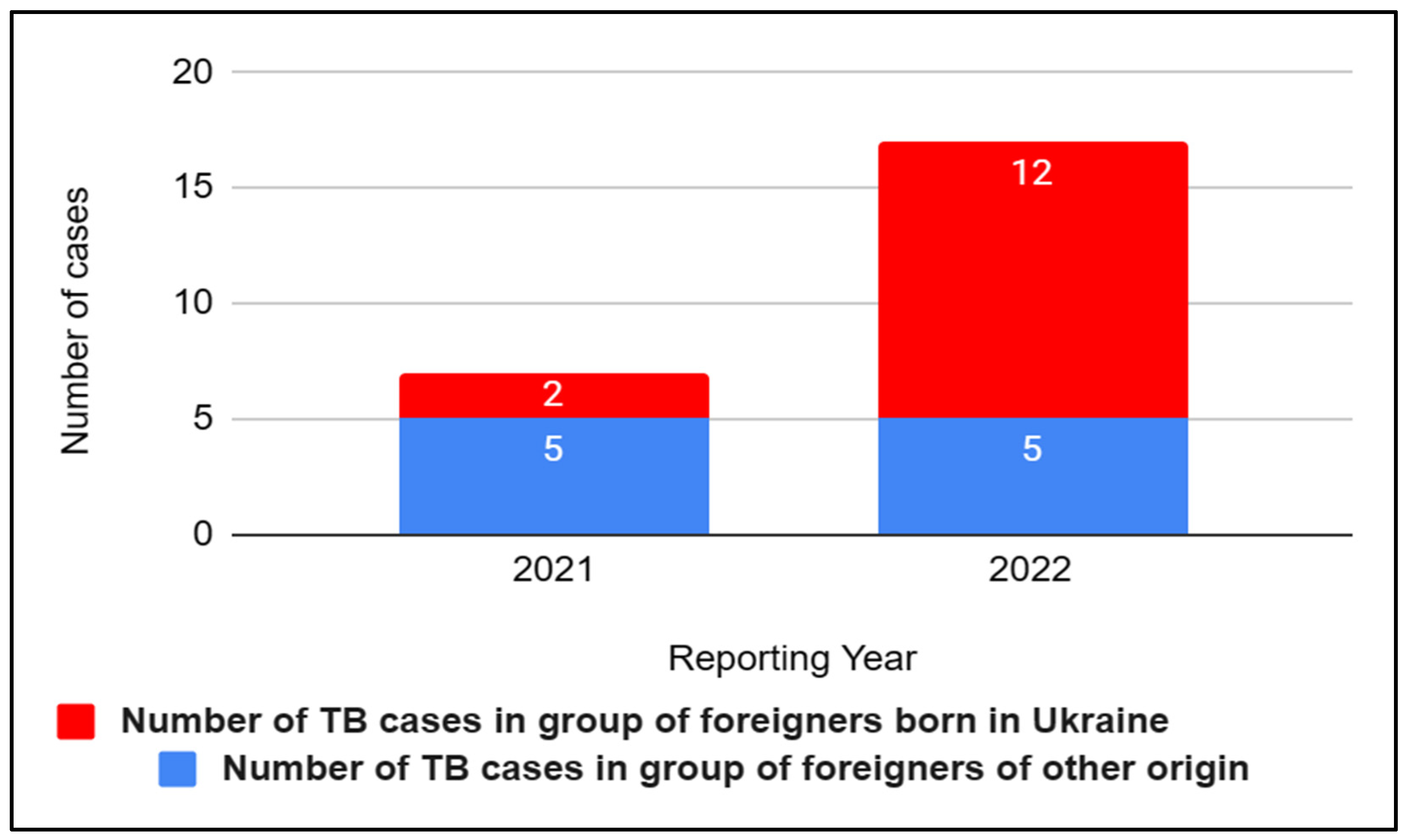
Disclaimer/Publisher’s Note: The statements, opinions and data contained in all publications are solely those of the individual author(s) and contributor(s) and not of MDPI and/or the editor(s). MDPI and/or the editor(s) disclaim responsibility for any injury to people or property resulting from any ideas, methods, instructions or products referred to in the content. |
© 2023 by the authors. Licensee MDPI, Basel, Switzerland. This article is an open access article distributed under the terms and conditions of the Creative Commons Attribution (CC BY) license (https://creativecommons.org/licenses/by/4.0/).
Share and Cite
Wilczek, N.A.; Brzyska, A.; Bogucka, J.; Sielwanowska, W.E.; Żybowska, M.; Piecewicz-Szczęsna, H.; Smoleń, A. The Impact of the War in Ukraine on the Epidemiological Situation of Tuberculosis in Europe. J. Clin. Med. 2023, 12, 6554. https://doi.org/10.3390/jcm12206554
Wilczek NA, Brzyska A, Bogucka J, Sielwanowska WE, Żybowska M, Piecewicz-Szczęsna H, Smoleń A. The Impact of the War in Ukraine on the Epidemiological Situation of Tuberculosis in Europe. Journal of Clinical Medicine. 2023; 12(20):6554. https://doi.org/10.3390/jcm12206554
Chicago/Turabian StyleWilczek, Natalia Anna, Anna Brzyska, Julia Bogucka, Wiktoria Ewa Sielwanowska, Monika Żybowska, Halina Piecewicz-Szczęsna, and Agata Smoleń. 2023. "The Impact of the War in Ukraine on the Epidemiological Situation of Tuberculosis in Europe" Journal of Clinical Medicine 12, no. 20: 6554. https://doi.org/10.3390/jcm12206554
APA StyleWilczek, N. A., Brzyska, A., Bogucka, J., Sielwanowska, W. E., Żybowska, M., Piecewicz-Szczęsna, H., & Smoleń, A. (2023). The Impact of the War in Ukraine on the Epidemiological Situation of Tuberculosis in Europe. Journal of Clinical Medicine, 12(20), 6554. https://doi.org/10.3390/jcm12206554





